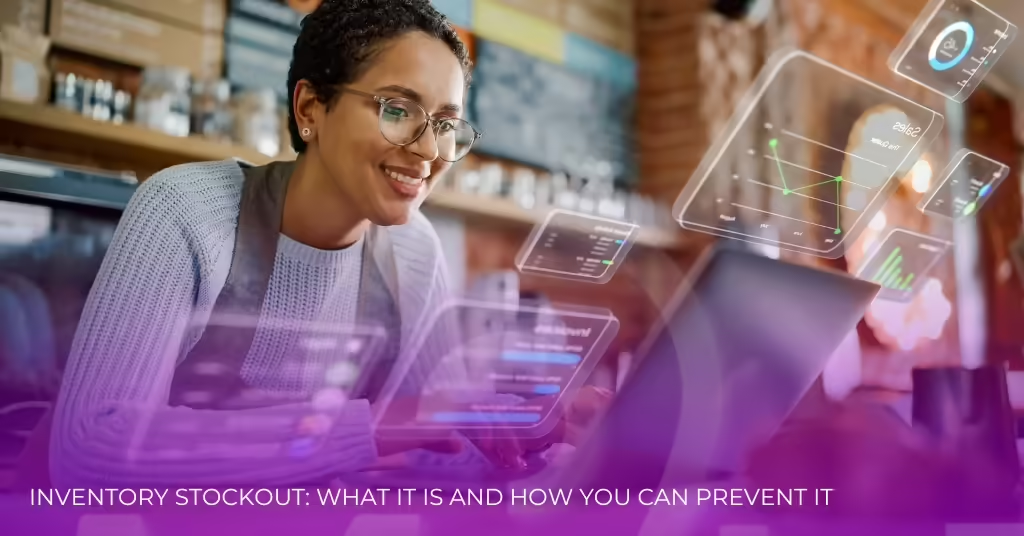يعد نفاد المخزون أمرًا سيئًا للشركات. في هذه المقالة، سنناقش ما هو هذا الأمر، وما هي أسبابه، وكيف يمكن لتجار التجزئة منع حدوثه.
يحدث هذا بالفعل. سواء كان الأمر يتعلق بمتجر متخصص صغير أو شركة تجارة إلكترونية عملاقة ذات مخزونات ضخمة، فإن تجار التجزئة، من وقت لآخر، ينفد مخزونهم تمامًا، وخاصةً فيما يتعلق بالعناصر التي تنفد بسرعة.
ما هو نفاد المخزون؟
يحدث نفاد المخزون عندما لا يكون المنتج متاحًا للشراء. يحدث هذا عادةً عندما ينفد أحد المنتجات من إحدى الشركات أو المستودعات أو عندما يتم بيع جميع المنتجات الموجودة في المخزون. يمكن تطبيق المصطلح المذكور على المتاجر التقليدية عندما يكون لديها نقص في عنصر معين، وكذلك على التجار عبر الإنترنت عندما ينفد منتج معين تمامًا. في كلتا الحالتين، يتعرض كلا النوعين من الشركات لخطر خذلان عملائهم لأنه لا يوجد دائمًا جدول زمني واضح لموعد توفر عنصر "نفد المخزون" مرة أخرى.
نفاد المخزون مقابل التخزين الزائد
يؤدي عدم وجود مخزون كافٍ لتلبية طلب العملاء إلى نفاد المخزون. ولكن عندما يكون الطلب منخفضًا ويكون لدى المتاجر مخزون أكبر مما يمكنها بيعه، تكون النتيجة هي فائض المخزون. يمكن أن تتراكم مشاكلك بسرعة إذا واصلت طلب كمية زائدة من منتج لن يتم بيعه أو طلبت منتجًا مطلوبًا بكمية أقل.
التأثير المالي
يؤدي الإفراط في التخزين إلى تقييد رأس المال في المخزون غير المباع، مما يؤدي إلى ضغوط مالية بسبب ارتفاع تكاليف التخزين. كما تضطر عن غير قصد إلى تقديم خصومات لتصفية المخزون الزائد، مما يؤدي في النهاية إلى تقليل هوامش الربح الخاصة بك. وعلى النقيض من ذلك، يؤدي نفاد المخزون إلى خسارة المبيعات والإيرادات حيث يلجأ العملاء إلى المنافسين لتلبية احتياجاتهم.
التحديات التشغيلية
وجود الكثير من المخزون في متناول اليد يؤدي نفاذ المخزون إلى العديد من التحديات التشغيلية، مثل الحاجة إلى مساحة تخزين إضافية، مما يزيد من تكاليف التخزين والتعقيدات اللوجستية. كما أن هناك خطرًا أكبر من أن تصبح المنتجات قديمة أو تالفة بمرور الوقت. وعلى العكس من ذلك، فإن نفاد المخزون يعطل قدرة المتجر على تلبية طلب العملاء، مما يتسبب في حدوث تأخيرات وتأخر الطلبات. وهذا يؤدي إلى زيادة التكاليف الإدارية حيث يسارع الموظفون إلى إدارة النقص وتسريع عمليات التجديد.
تجربة العملاء
من وجهة نظر تجربة العملاء، يمكن أن يؤدي الإفراط في التخزين إلى مبيعات وعروض ترويجية متكررة تهدف إلى التخلص من المخزون الزائد، مما قد يؤدي إلى تآكل القيمة المتصورة للمنتجات والعلامة التجارية. عندما يبدأ المزيد والمزيد من العملاء في توقع رؤية الخصومات، فقد لا تتمكن أبدًا من البيع بالسعر الكامل مرة أخرى. من ناحية أخرى، يمكن أن يؤثر نفاد المخزون بشكل كبير على ولاء العملاء، حيث قد يتحول العملاء غير الراضين إلى المنافسين الذين يلبيون احتياجاتهم باستمرار.
نصيحة احترافية: يمكنك تجنب نفاد المخزون أو المخزون الزائد عن طريق تنفيذ برنامج إدارة المخزون للتجارة الإلكترونيةسيساعدك ذلك على اكتشاف أنماط نفاد المخزون واستبعاد ارتفاع المبيعات لمرة واحدة من تحليلك التاريخي. باستخدام هذه المعلومات، يمكنك إجراء توقعات أفضل للطلب واستخدامها لتوجيه تحركات شركتك المستقبلية.
ما هي عيوب نفاد المخزون؟
أ هارفارد بيزنس ريفيو كشفت دراسة أجريت على أكثر من 600 منفذ بيع بالتجزئة أن نفاد المخزون أكثر تكلفة بكثير مما تعتقد معظم الشركات. يمكن أن يؤدي نفاد المخزون إلى خسارة كبيرة في رأس المال وسمعة العلامة التجارية، كما حددنا للتو. ولكن هناك المزيد من المخاطر التي قد يكون لها عواقب بعيدة المدى على الشركات الصغيرة.
فقدان العملاء
يكره العملاء بالفعل استلام المنتج الخطأ في شحناتهم. تخيل الضجة التي سيثيرونها عندما يزورون متجرك لشراء منتج، فقط ليكتشفوا أنه غير متوفر - ليس مرة واحدة، وليس مرتين، بل ثلاث مرات متتالية. لإعطائك بعض المنظور، وفقًا لأحد استطلاع ماكينزي, 7 من كل 10 عملاء يغيرون العلامة التجارية عندما يكون المنتج الذي يرغبون فيه "غير متوفر مؤقتًا". فقط 13% ظل مخلصًا لعلامته التجارية وانتظر إعادة تخزين المنتج.
الكلام السلبي
كما أظهرت الأبحاث أن المراجعات السلبية تثني العملاء المحتملين عن التعامل مع شركة ما. وببساطة، فإن مراجعة سيئة واحدة حول نفاد المخزون بشكل متكرر قد تكلفك مئات الآلاف من الدولارات من الإيرادات.
زيادة النفقات التشغيلية
عندما ينخفض مخزونك، ترتفع نفقاتك التشغيلية حتمًا لأنك تقضي ساعات لا حصر لها في الاتصال بمستودعات خارجية للحصول على أي مخزون غير مستخدم محتمل وتحديد البائعين الذين يتمتعون بالمرونة الكافية لتلبية طلباتك في غضون مهلة قصيرة. قد تضطر حتى إلى تحمل تكلفة الشحن الجوي الإضافية لتسريع التسليم.
ما الذي يسبب نفاد المخزون؟
نظرًا لوجود العديد من الأجزاء المتحركة المشاركة في نقل المنتج من وحدة التصنيع إلى مركز الوفاء الخاص بشركتك أو متجر البيع بالتجزئة، فسوف تواجه شركتك تشوهات المخزون في مرحلة ما.
دعونا نلقي نظرة على خمسة أسباب شائعة لنفاد المخزون.
تحليل الطلب غير الدقيق
خلال جائحة كوفيد-19، ارتفع الطلب على أقنعة الوجه ومعقمات اليدين بشكل كبير. وعلى نحو مماثل، غالبًا ما تؤدي موجة البرد المفاجئة أو بداية الطقس الشتوي المبكر إلى زيادة حادة في الطلب على الملابس الشتوية. يمكن أن تصبح قطعة الملابس أو الإكسسوار التي يرتديها المشاهير أو المؤثرون على إنستغرام أيضًا بسرعة عنصرًا مطلوبًا للغاية. باختصار، تتغير رغبة العملاء في الشراء مع تغير الظروف البيئية والمواسم واتجاهات الموضة.
ولكن على الرغم من أن هذه المعرفة عامة، فإن العديد من تجار التجزئة يفشلون في التخطيط مقدمًا للتغيرات المفاجئة في أنماط شراء عملائهم. بالإضافة إلى ذلك، يمكن أن تؤدي الأخطاء في إدخال البيانات أو نماذج التنبؤ إلى إدارة غير فعّالة للطلب ومستويات مخزون غير كافية. ولا عجب إذن أنه ليس من غير المألوف أن تتعرض المنتجات الأكثر شعبية في المتجر لنفاد المخزون بشكل متكرر ولا مفر منه تقريبًا.
سجلات غير دقيقة
السبب الشائع الثاني لنفاد المخزون هو إحصاءات المخزون غير الصحيحة. في أغلب الأحيان، تكون هذه التناقضات نتيجة لأخطاء بشرية. على سبيل المثال، يدير موظفو المستودعات المخزون يدويًا ويحسبون العناصر الخطأ أو يكتبون الكمية الخطأ. مثال آخر هو عندما يفقد الأشخاص العد للعناصر التي يفرغونها من المستودع. سيناريو آخر يمكن أن يؤثر على عدد المنتجات هو إذا لم يتم تحديث أرقام مخزون الشركة في الوقت الفعلي عبر جميع قنوات المبيعات الخاصة بها. يمكن أن تؤدي كل هذه التناقضات في أعداد العناصر إلى نفاد المخزون.
الرؤية محدودة أو معدومة
السبب الرئيسي الثالث لنفاد المخزون (وبالتالي المخزون الزائد) هو عدم القدرة على رؤية مخزون الشركة. فمن الصعب للغاية الحفاظ على مستويات مخزون كافية لتلبية طلب العملاء إذا لم تكن على علم بمستويات مخزونك الحالية.
كما أن عدم القدرة على رؤية الموقع المحدد لعنصر ما في المستودع يؤدي إلى تفاقم عدم الكفاءة التشغيلية. ويؤدي ذلك إلى إطالة أوقات الالتقاط، وتأخير تنفيذ الطلبات، وزيادة تكاليف العمالة. وقد يؤدي هذا الافتقار إلى إمكانية تتبع المخزون إلى إساءة وضع العناصر، وصعوبة إدارة المرتجعات، وانخفاض الإنتاجية الإجمالية.
إعادة التخزين غير الفعالة/المتأخرة
في كثير من الأحيان، تتسبب المشكلات المتعلقة بتوريد المواد الخام أو تسليم المكونات إلى الشركات المصنعة في نفاد المخزون في أي مرحلة من مراحل سلسلة التوريد. وبالتالي، قد يتبع ذلك تأخير الإنتاج ونفاد المخزون. إذا كان الأمر كذلك، فقد حان الوقت لتحسين سير عمل إعادة التخزين.
قضايا التسليم
لوجستية قد تتسبب مشكلات مثل الأداء غير الكافي لشركة التوصيل، والمستندات غير المكتملة، وتأخير التخليص الجمركي، والكوارث الطبيعية، في تأخر وصول الشحنات. كما قد تتسبب أعطال المركبات أو الحوادث في تأخير التسليم، وقد تتسبب المشكلات الميكانيكية أيضًا في تأخير جداول الإنتاج. نظرًا لأنك لا تملك عادةً أي تأثير على معظم هذه الظروف غير المتوقعة، فمن الأفضل أن تكون مستعدًا بدلاً من أن تندم.
علامات تشير إلى أنك تتجه نحو نفاد مخزونك وكيف يمكنك منعها
إن إدارة المخزون بشكل فعّال أمر بالغ الأهمية لأي عمل تجاري، وخاصة تلك التي تتعامل في السلع المادية. وكما ذكرنا أعلاه، فإن نفاد المخزون قد يكون له عواقب وخيمة على رضا العملاء والإيرادات الصافية. إن التعرف على علامات التحذير في وقت مبكر يمكن أن يساعد الشركات على اتخاذ تدابير استباقية لتجنب نفاد المخزون. وفيما يلي بعض المؤشرات الرئيسية التي قد تشير إلى أنك على وشك نفاد المخزون:
انخفاض مستويات المخزون
من أكثر العلامات وضوحًا لنفاد المخزون الوشيك هو انخفاض مستويات المخزون بشكل مطرد. يمكن أن يساعدك مراقبة مخزونك بانتظام وتتبع مستويات المخزون في تحديد وقت انخفاض العناصر. يتضمن هذا:
التدقيق الدوري وفحص المخزون: قم بإجراء عمليات تدقيق المخزون بشكل متكرر للبقاء على اطلاع بمستويات المخزون الحالية. فكر في استخدام برنامج إدارة المخزون لأتمتة هذه العملية واستخراج رؤى قابلة للتنفيذ من البيانات في الوقت الفعلي.
تحليل بيانات المبيعات التاريخية: قم بتحليل بيانات المبيعات السابقة للتنبؤ بالطلب المستقبلي. إذا كانت مبيعاتك مستقرة، فيمكنك تقدير موعد الحاجة إلى إعادة ترتيب المخزون. ومع ذلك، يجب عليك أيضًا مراعاة أي ارتفاعات مفاجئة في المبيعات أو الاتجاهات الموسمية.
إعداد نقاط إعادة الطلب: خصص نقاط إعادة الطلب لكل عنصر لضمان تجديد المخزون قبل نفاده. يجب تعيين هذه النقطة أعلى بالنسبة للعناصر سريعة الحركة وأقل بالنسبة للعناصر بطيئة الحركة.
مستويات المخزون الآمن: احتفظ بمخزون احتياطي أو احتياطي لمنع نفاد المخزون بسبب الطلب غير المتوقع أو انقطاع سلسلة التوريد. ضع في اعتبارك أوقات التسليم والتباين في الطلب والعرض عند حساب الكمية المناسبة من المخزون الاحتياطي.
زيادة الطلبات المؤجلة
إن زيادة الطلبات المؤجلة هي علامة واضحة أخرى على اقتراب نفاد المخزون بسرعة. تحدث الطلبات المؤجلة عندما لا يمكن تلبية الطلبات بسبب عدم كفاية المخزون، مما يؤدي إلى تأخير التسليم. أفضل طريقة لإدارة الطلبات المؤجلة وتفسيرها هي تتبع وتيرة وحجم الطلبات المؤجلة وتحديد الأنماط للتنبؤ بنفاد المخزون في المستقبل. إن الاتجاه المتزايد للطلبات المؤجلة هو علامة واضحة على أن مستويات المخزون لديك لا تلبي طلب العملاء.
تأخر الشحنات من البائعين
يعد البائعون جانبًا أساسيًا في إدارة المخزون. يمكن أن يؤدي التأخير في شحنات البائعين إلى نفاد المخزون بسرعة. اتخذ الخطوات التالية للتخفيف من هذا الخطر:
مراقبة أداء البائعين: قم بتقييم أداء البائعين بشكل منتظم بناءً على أوقات التسليم ودقة الطلب والتواصل. يساعد هذا في تحديد البائعين غير الموثوق بهم واتخاذ الإجراءات التصحيحية.
بائعين متعددين: إن الاعتماد على بائع واحد يزيد من خطر نفاد المخزون إذا واجه هذا البائع اضطرابات. قم بتنويع قاعدة البائعين لديك لتقليل الاعتماد المفرط.
تقليل وقت التسليم: العمل عن كثب مع البائعين لتقليل أوقات التسليم. قد يتضمن هذا التفاوض على طرق شحن أسرع، أو تحسين أوقات معالجة الطلبات، أو التعاون في ممارسات إدارة المخزون.
الشراكات الاستراتيجية: تشكيل شراكات استراتيجية مع البائعين الرئيسيين لضمان المعاملة ذات الأولوية والتفاوض على شروط أفضل، مثل أوقات التنفيذ الأقصر وكميات الطلبات الأكثر مرونة.
ارتفاع شكاوى العملاء
شكاوى العملاء بشأن توافر المخزون هي مؤشر مباشر على وجود مشكلات في المخزون. وقد تؤدي الشكاوى المتزايدة إلى الإضرار بسمعة علامتك التجارية وتؤدي إلى خسارة المبيعات. ومن الضروري معالجة هذه الشكاوى بشكل استباقي.
قنوات آراء العملاء: أنشئ قنوات متعددة ليتمكن العملاء من تقديم ملاحظاتهم، مثل الاستطلاعات ووسائل التواصل الاجتماعي والتواصل المباشر. سيمنحك تحليل هذه الملاحظات رؤى قيمة حول مشاكل المخزون.
تحليل الشكوى: قم بتصنيف شكاوى العملاء وفقًا لنوعها وتكرارها وتأثيرها. قم بإعداد قائمة بالمشكلات الأكثر شيوعًا وخطورة والتي تؤثر على تجربة المستخدم. الآن، حدد الأسباب الجذرية لهذه المشكلات وحدد أولويات التدابير التصحيحية وفقًا لذلك.
تحسين خدمة العملاء: قم بتدريب فرق خدمة العملاء على أفضل السبل للتعامل مع حالات نفاد المخزون بتعاطف. قدم لهم بدائل مثل اقتراح منتجات مماثلة أو تقديم خيارات الطلب المؤجل.
الشفافية والتواصل: أطلع العملاء على مستويات المخزون وأوقات إعادة التخزين المقدرة والخيارات البديلة لإدارة توقعاتهم والحد من عدم الرضا. تعد الشفافية أمرًا محوريًا للحفاظ على ثقة العملاء.
إعادة التخزين في حالات الطوارئ المتكررة
إن إعادة التخزين في حالات الطوارئ المتكررة هي نهج تفاعلي لإدارة المخزون يعكس ضعف التخطيط والتنبؤ من جانبك. وقد تكون هذه الممارسة مكلفة وغير فعّالة، مما يؤدي إلى ارتفاع تكاليف التشغيل ونفاد المخزون المحتمل. لحل هذه المشكلة، ضع في اعتبارك ما يلي:
تخطيط المخزون والتنبؤ به: تتمثل إحدى الطرق لتقليل الحاجة إلى إعادة التخزين على عجل في التنبؤ بالطلب بدقة. ويتضمن هذا استخدام برنامج جيد للتنبؤ بالطلب مزود بأدوات وتقنيات أكثر تطوراً، مثل خوارزميات التعلم الآلي، للتنبؤ بالطلب المستقبلي بدقة أكبر.
أنظمة التجديد الآلي: يمكن أن يؤدي تنفيذ أنظمة التجديد التلقائية إلى تبسيط عملية إعادة التخزين. تستخدم هذه الأنظمة البيانات في الوقت الفعلي لتحفيز الطلبات عندما تصل مستويات المخزون إلى عتبات محددة مسبقًا، مما يقلل من الحاجة إلى إعادة التخزين في حالات الطوارئ.
مراجعة المخزون بشكل منتظم: قم بإجراء مراجعات المخزون بشكل منتظم. قم بتحليل معدلات دوران المخزون، وأوقات التسليم، وتقلبات الطلب. سيساعدك هذا في تحديد مخاطر نفاد المخزون المحتملة ومعالجتها قبل أن تصبح حرجة.
تحكم في مخزونك. اختر مايل!
يتطلب منع نفاد المخزون اتباع نهج استباقي واستراتيجي لإدارة المخزون. يحتوي برنامج إدارة التوصيل لدينا على وحدة إدارة مخزون متكاملة ستساعدك على:
- مراقبة مستويات المخزون
- تحليل اتجاهات الطلبات المؤجلة
- إدارة علاقات البائعين
- معالجة شكاوى العملاء
- تقليل الحاجة إلى إعادة التخزين في حالات الطوارئ
لذا، إذا كنت تريد تقليل مخاطر نفاد المخزون وضمان إمداد ثابت من المنتجات لتلبية الطلبات بسلاسة، اتصل بنا اليوم!

